Hyundai Ioniq Hybrid 2017 Owner's Manual
Manufacturer: HYUNDAI, Model Year: 2017, Model line: Ioniq Hybrid, Model: Hyundai Ioniq Hybrid 2017Pages: 553, PDF Size: 59.51 MB
Page 511 of 553
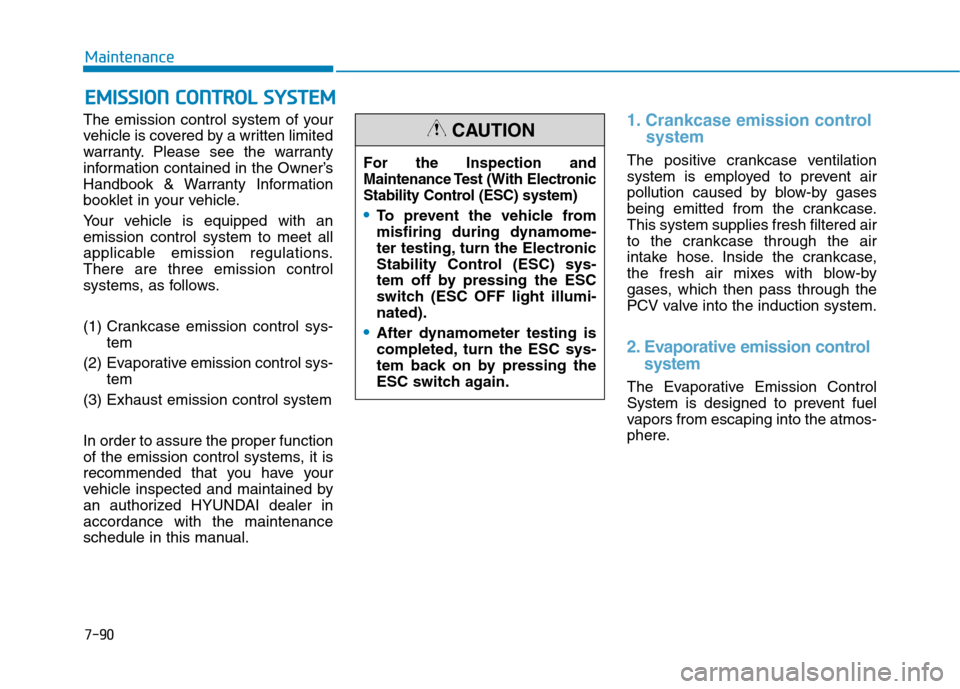
7-90
MaintenanceE
E MM IISS SSIIOO NN CC OO NNTTRR OO LL SS YY SSTT EEMM
The emission control system of your
vehicle is covered by a written limited
warranty. Please see the warranty
information contained in the Owner’s
Handbook & Warranty Information
booklet in your vehicle.
Your vehicle is equipped with an emission control system to meet all
applicable emission regulations.There are three emission control
systems, as follows.
(1) Crankcase emission control sys-
tem
(2) Evaporative emission control sys- tem
(3) Exhaust emission control systemIn order to assure the proper function
of the emission control systems, it is
recommended that you have your
vehicle inspected and maintained by
an authorized HYUNDAI dealer inaccordance with the maintenance
schedule in this manual.1. Crankcase emission control system
The positive crankcase ventilation
system is employed to prevent air
pollution caused by blow-by gases
being emitted from the crankcase.This system supplies fresh filtered air
to the crankcase through the air
intake hose. Inside the crankcase,
the fresh air mixes with blow-by
gases, which then pass through the
PCV valve into the induction system.
2. Evaporative emission controlsystem
The Evaporative Emission Control
System is designed to prevent fuel
vapors from escaping into the atmos-
phere.
For the Inspection and
Maintenance Test (With Electronic
Stability Control (ESC) system)
To prevent the vehicle from
misfiring during dynamome-
ter testing, turn the Electronic
Stability Control (ESC) sys-
tem off by pressing the ESC
switch (ESC OFF light illumi-nated).
After dynamometer testing is
completed, turn the ESC sys-
tem back on by pressing the
ESC switch again.
CAUTION
Page 512 of 553
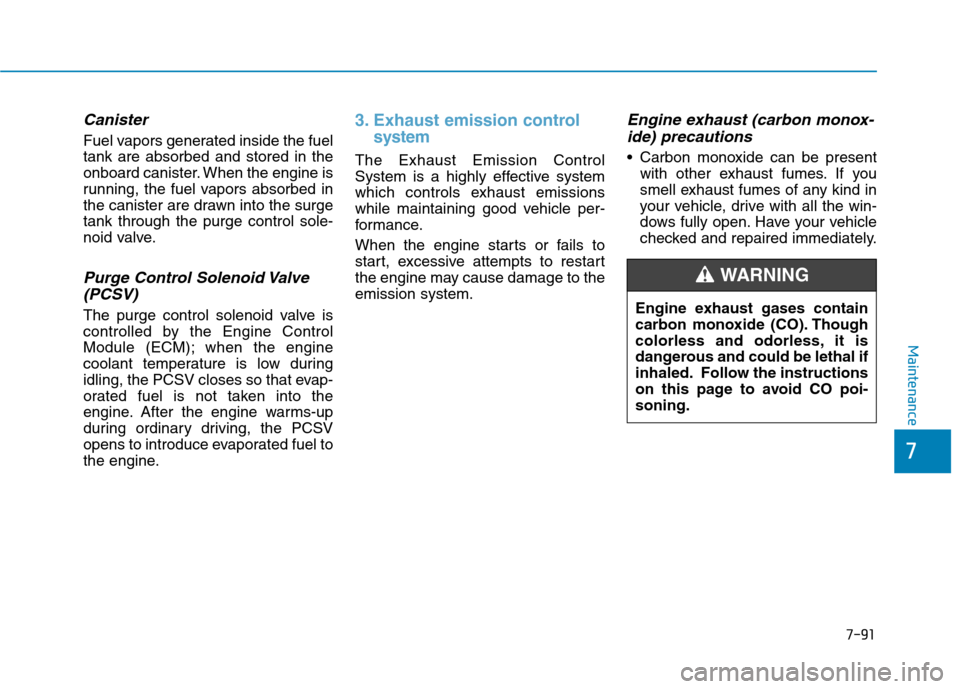
7-91
7
Maintenance
Canister
Fuel vapors generated inside the fuel tank are absorbed and stored in the
onboard canister. When the engine is
running, the fuel vapors absorbed in
the canister are drawn into the surgetank through the purge control sole-
noid valve.
Purge Control Solenoid Valve(PCSV)
The purge control solenoid valve is
controlled by the Engine Control
Module (ECM); when the engine
coolant temperature is low during
idling, the PCSV closes so that evap-
orated fuel is not taken into the
engine. After the engine warms-up
during ordinary driving, the PCSV
opens to introduce evaporated fuel to
the engine.
3. Exhaust emission control system
The Exhaust Emission Control
System is a highly effective system
which controls exhaust emissions
while maintaining good vehicle per-
formance.
When the engine starts or fails to
start, excessive attempts to restart
the engine may cause damage to theemission system.
Engine exhaust (carbon monox-
ide) precautions
Carbon monoxide can be present with other exhaust fumes. If you
smell exhaust fumes of any kind in
your vehicle, drive with all the win-
dows fully open. Have your vehicle
checked and repaired immediately.
Engine exhaust gases contain
carbon monoxide (CO). Though
colorless and odorless, it is
dangerous and could be lethal if
inhaled. Follow the instructions
on this page to avoid CO poi-soning.
WARNING
Page 513 of 553
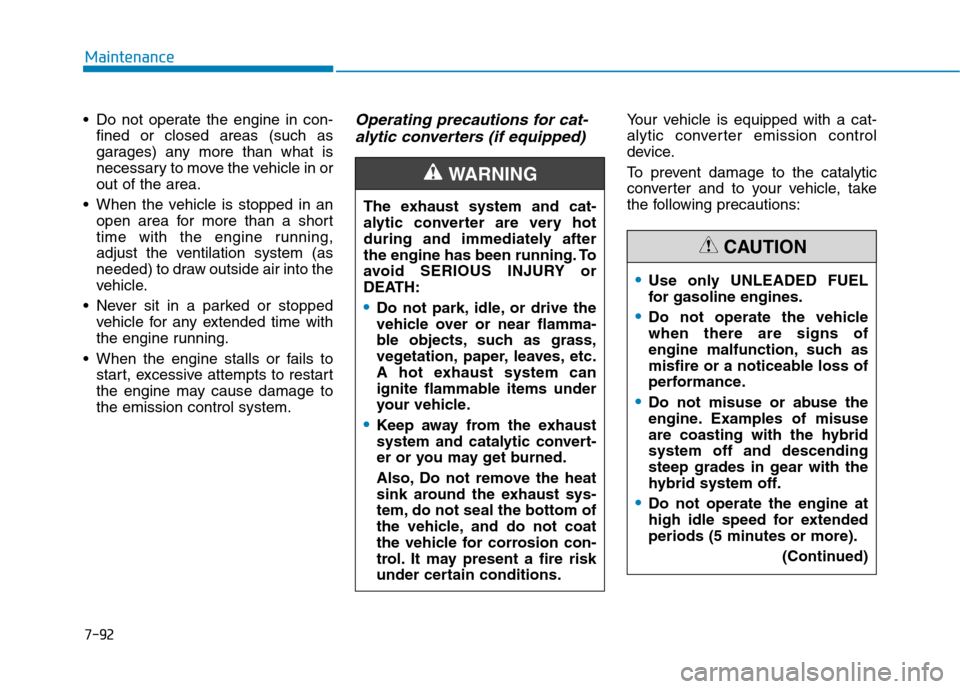
7-92
Maintenance
Do not operate the engine in con-fined or closed areas (such as
garages) any more than what is
necessary to move the vehicle in orout of the area.
When the vehicle is stopped in an open area for more than a short
time with the engine running,
adjust the ventilation system (as
needed) to draw outside air into the
vehicle.
Never sit in a parked or stopped vehicle for any extended time with
the engine running.
When the engine stalls or fails to start, excessive attempts to restart
the engine may cause damage tothe emission control system.Operating precautions for cat-
alytic converters (if equipped)Your vehicle is equipped with a cat-
alytic converter emission control
device.
To prevent damage to the catalytic
converter and to your vehicle, take
the following precautions:
The exhaust system and cat-
alytic converter are very hot
during and immediately after
the engine has been running. To
avoid SERIOUS INJURY or
DEATH:
Do not park, idle, or drive the
vehicle over or near flamma-
ble objects, such as grass,
vegetation, paper, leaves, etc.
A hot exhaust system can
ignite flammable items under
your vehicle.
Keep away from the exhaust
system and catalytic convert-
er or you may get burned.
Also, Do not remove the heat
sink around the exhaust sys-
tem, do not seal the bottom of
the vehicle, and do not coat
the vehicle for corrosion con-
trol. It may present a fire risk
under certain conditions.
WARNING
Use only UNLEADED FUEL
for gasoline engines.
Do not operate the vehicle when there are signs of
engine malfunction, such as
misfire or a noticeable loss of
performance.
Do not misuse or abuse the
engine. Examples of misuse
are coasting with the hybridsystem off and descending
steep grades in gear with the
hybrid system off.
Do not operate the engine at
high idle speed for extended
periods (5 minutes or more).
(Continued)
CAUTION
Page 514 of 553
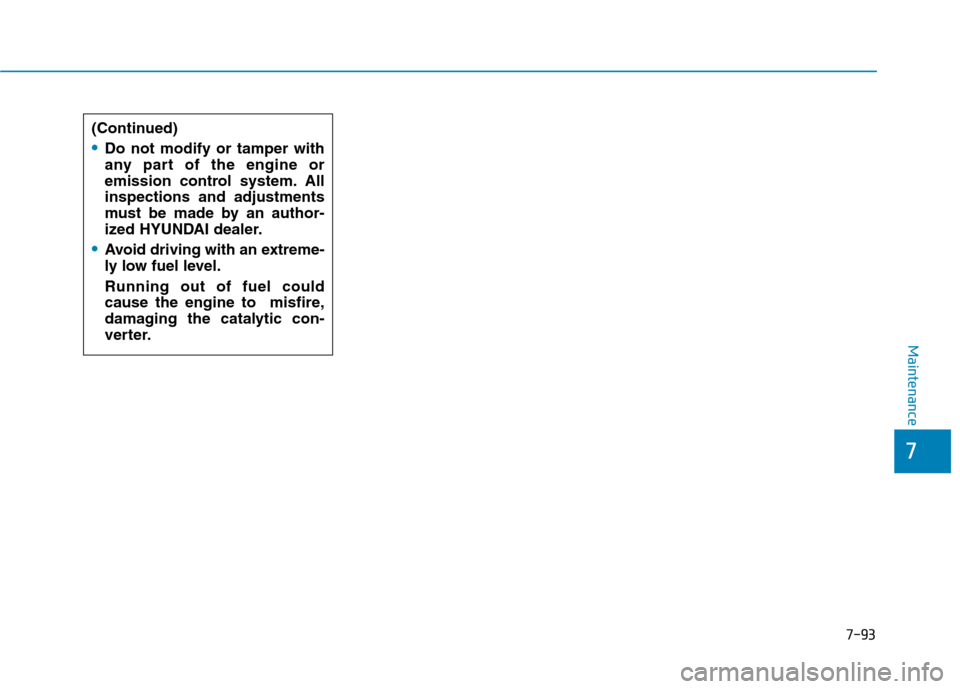
7-93
7
Maintenance
(Continued)
Do not modify or tamper with
any part of the engine or
emission control system. Allinspections and adjustments
must be made by an author-
ized HYUNDAI dealer.
Avoid driving with an extreme-
ly low fuel level. Running out of fuel could
cause the engine to misfire,
damaging the catalytic con-
verter.
Page 515 of 553
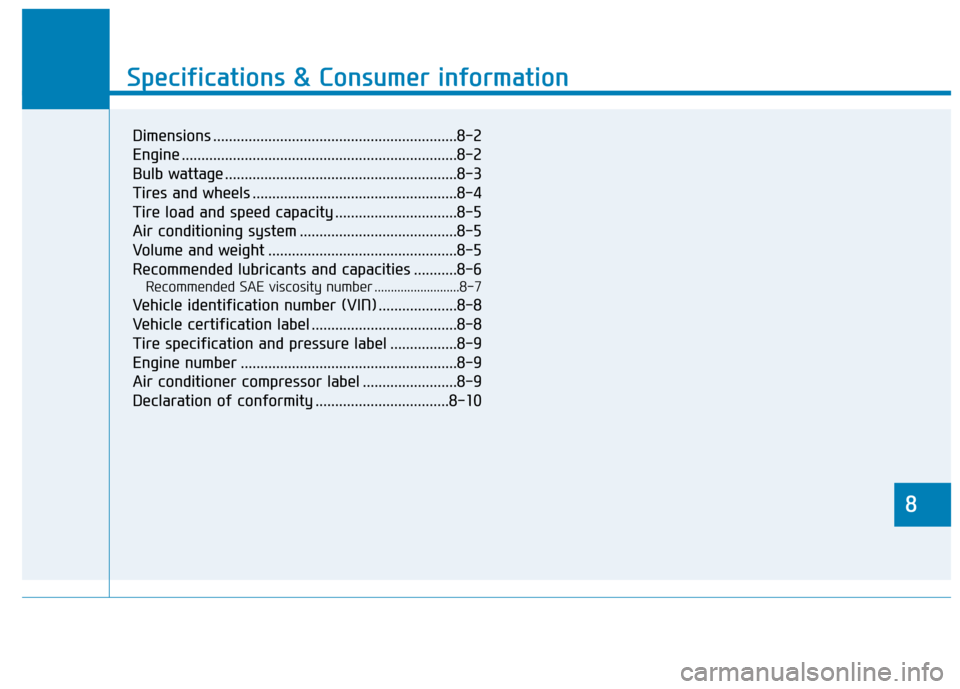
8
Specifications & Consumer information
8
Specifications & Consumer information
8
Dimensions ..............................................................8-2
Engine ......................................................................8-2
Bulb wattage ...........................................................8-3
Tires and wheels ....................................................8-4
Tire load and speed capacity ...............................8-5
Air conditioning system ........................................8-5
Volume and weight ................................................8-5
Recommended lubricants and capacities ...........8-6Recommended SAE viscosity number ..........................8-7
Vehicle identification number (VIN) ....................8-8
Vehicle certification label .....................................8-8
Tire specification and pressure label .................8-9
Engine number .......................................................8-9
Air conditioner compressor label ........................8-9
Declaration of conformity ..................................8-10
Page 516 of 553
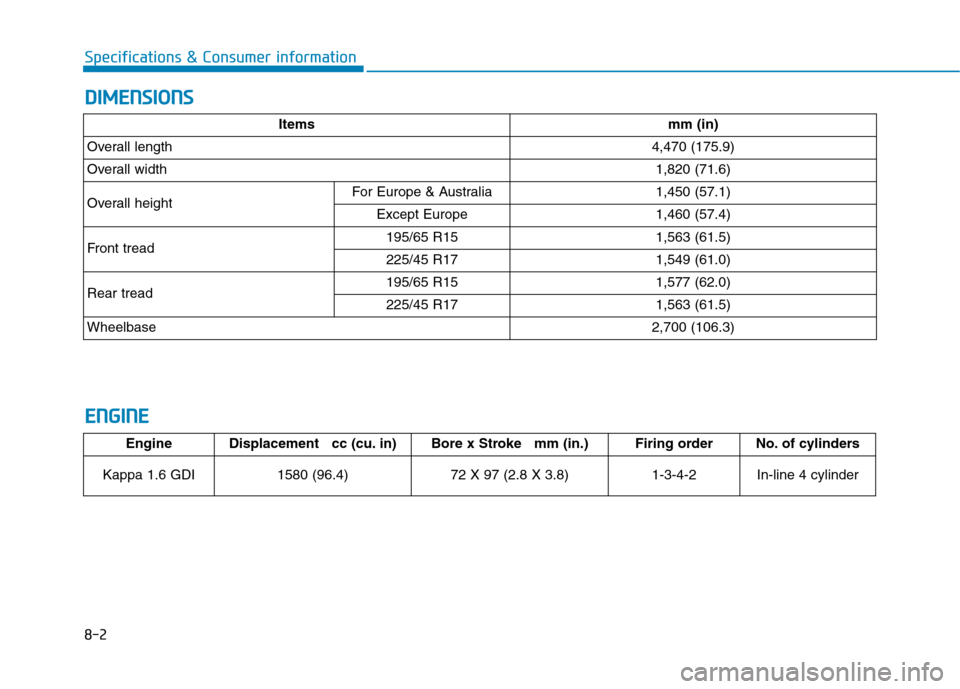
8-2
Specifications & Consumer informationD
D IIMM EENN SSIIOO NNSS
E
E NN GGIINN EE
EngineDisplacement cc (cu. in) Bore x Stroke mm (in.)Firing orderNo. of cylinders
Kappa 1.6 GDI
1580 (96.4) 72 X 97 (2.8 X 3.8)1-3-4-2In-line 4 cylinder
Itemsmm (in)
Overall length4,470 (175.9)
Overall width1,820 (71.6)
Overall heightFor Europe & Australia1,450 (57.1)
Except Europe1,460 (57.4)
Front tread195/65 R151,563 (61.5)
225/45 R171,549 (61.0)
Rear tread 195/65 R151,577 (62.0)
225/45 R171,563 (61.5)
Wheelbase2,700 (106.3)
Page 517 of 553
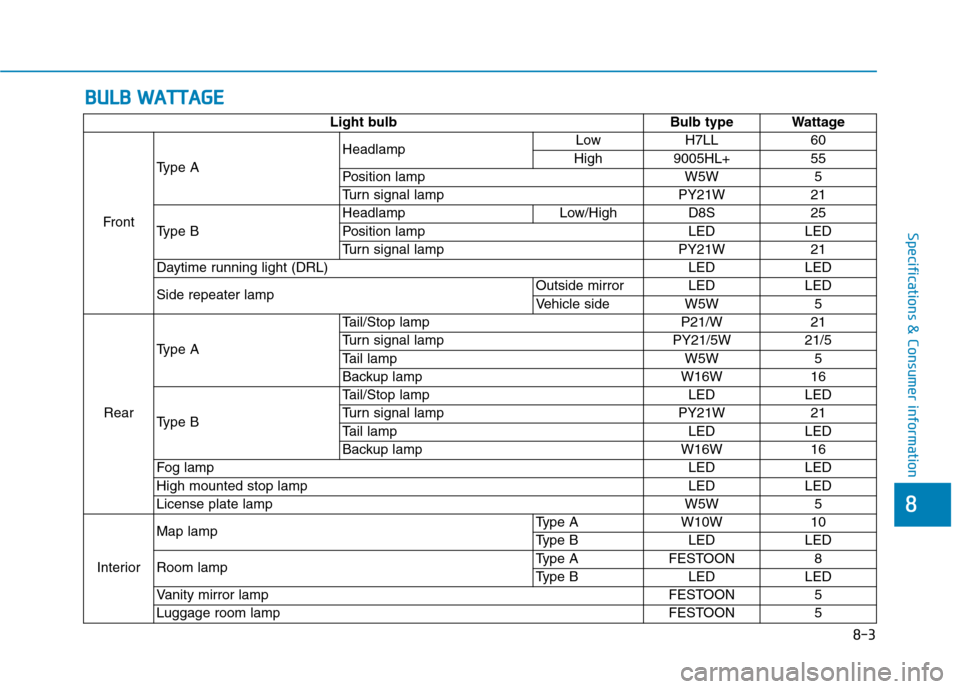
8-3
8
Specifications & Consumer information
BBUU LLBB WW AATTTTAA GG EE
Light bulb Bulb type Wattage
Front Type A
Headlamp
Low H7LL 60
High 9005HL+ 55
Position lamp W5W 5
Turn signal lamp PY21W 21
Type B Headlamp Low/High D8S 25
Position lamp
LED LED
Turn signal lamp PY21W 21
Daytime running light (DRL) LED LED
Side repeater lamp Outside mirror LED LED
Vehicle side W5W 5
Rear Type A
Tail/Stop lamp
P21/W 21
Turn signal lamp PY21/5W 21/5
Tail lamp W5W 5
Backup lamp W16W 16
Type B Tail/Stop lamp
LED LED
Turn signal lamp PY21W 21
Tail lamp LED LED
Backup lamp W16W 16
Fog lamp LED LED
High mounted stop lamp LED LED
License plate lamp W5W 5
Interior Map lamp
Type A W10W 10
Type B LED LED
Room lamp Type A FESTOON 8
Type B LED LED
Vanity mirror lamp FESTOON 5
Luggage room lamp FESTOON 5
Page 518 of 553
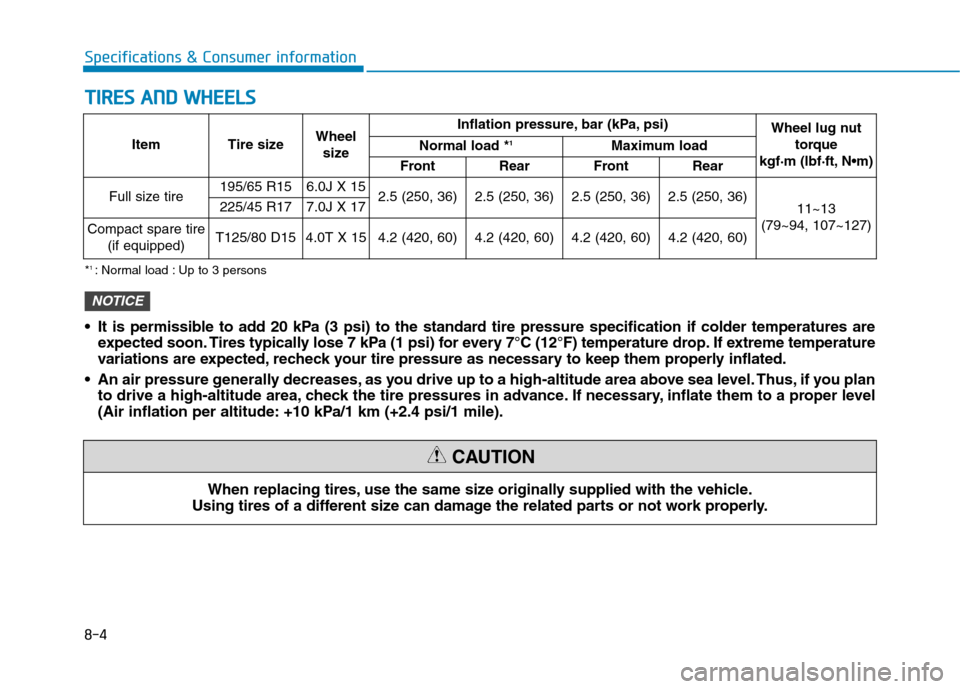
8-4
Specifications & Consumer informationT
T IIRR EESS AA NN DD WW HHEEEELLSS
Item Tire size Wheel
size Inflation pressure, bar (kPa, psi)
Wheel lug nut
torque
kgf·m (lbf·ft, N
Normal load *
1
Maximum load
Front Rear Front Rear
Full size tire 195/65 R15 6.0J X 15
2.5 (250, 36) 2.5 (250, 36) 2.5 (250, 36) 2.5 (250, 36)
11~13
(79~94, 107~127)
225/45 R17 7.0J X 17
Compact spare tire
(if equipped)T125/80 D154.0T X 154.2 (420, 60)4.2 (420, 60)4.2 (420, 60)4.2 (420, 60)
When replacing tires, use the same size originally supplied with the vehicle.
Using tires of a different size can damage the related parts or not work properly.
CAUTION
* 1
: Normal load : Up to 3 persons
It is permissible to add 20 kPa (3 psi) to the standard tire pressure specification if colder temperatures are expected soon. Tires typically lose 7 kPa (1 psi) for every 7°C (12°F) temperature drop. If extreme temperature
variations are expected, recheck your tire pressure as necessary to keep them properly inflated.
An air pressure generally decreases, as you drive up to a high-altitude area above sea level. Thus, if you plan to drive a high-altitude area, check the tire pressures in advance. If necessary, inflate them to a proper level
(Air inflation per altitude: +10 kPa/1 km (+2.4 psi/1 mile).
NOTICE
Page 519 of 553
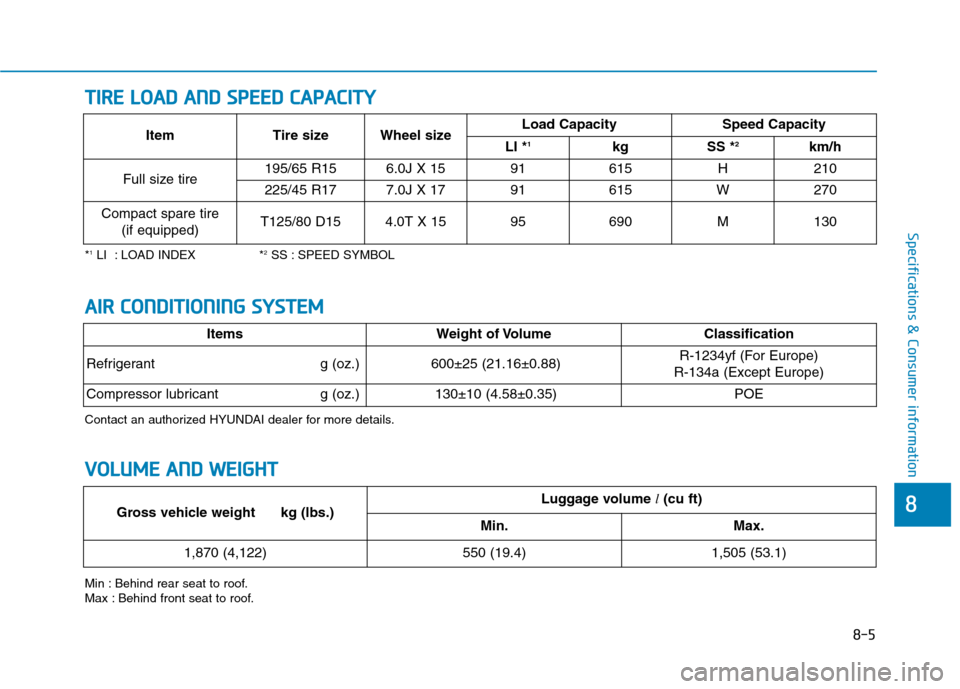
8-5
8
Specifications & Consumer information
TTIIRR EE LL OO AADD AA NN DD SS PP EEEE DD CC AA PPAA CCIITT YY
*1
LI : LOAD INDEX * 2
SS : SPEED SYMBOL
Min : Behind rear seat to roof.
Max : Behind front seat to roof. Item Tire size Wheel size
Load Capacity Speed Capacity
LI * 1
kg SS * 2
km/h
Full size tire 195/65 R15 6.0J X 15 91 615 H 210
225/45 R17 7.0J X 17 91 615 W 270
Compact spare tire
(if equipped)T125/80 D154.0T X 1595690M130
VVOO LLUU MM EE AA NN DD WW EEIIGG HH TT
Gross vehicle weight kg (lbs.)Luggage volume l(cu ft)
Min.Max.
1,870 (4,122)550 (19.4)1,505 (53.1)
AA IIRR CC OO NNDDIITT IIOO NNIINN GG SS YY SSTT EEMM
ItemsWeight of Volume Classification
Refrigerant g (oz.)600±25 (21.16±0.88)R-1234yf (For Europe)
R-134a (Except Europe)
Compressor lubricant g (oz.)130±10 (4.58±0.35)POE
Contact an authorized HYUNDAI dealer for more details.
Page 520 of 553
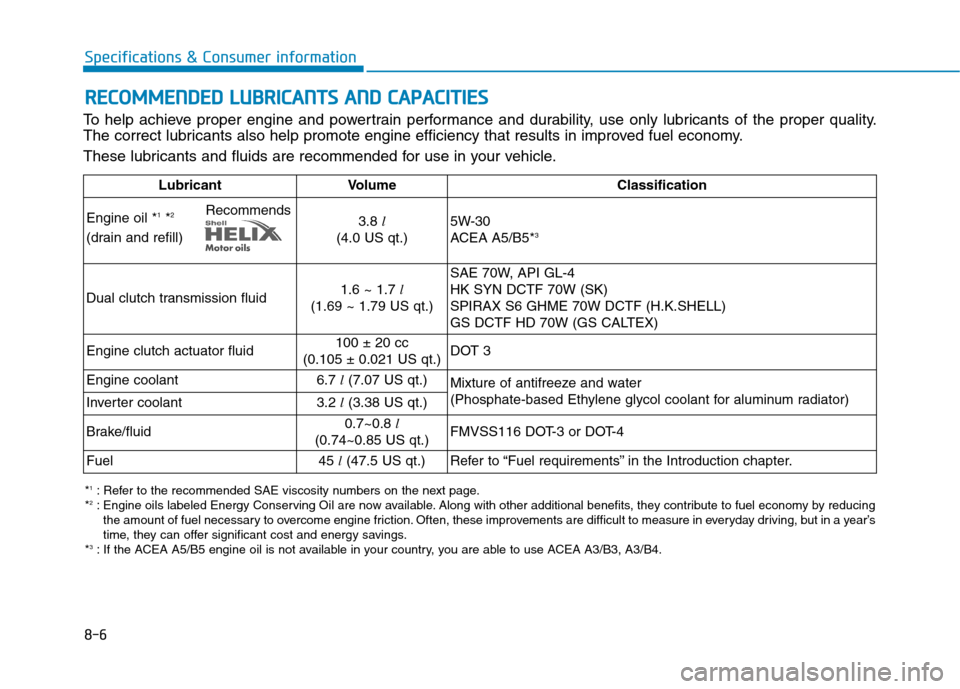
8-6
Specifications & Consumer informationR
R EECCOO MM MMEENN DDEEDD LL UU BBRRIICC AA NN TTSS AA NN DD CC AA PPAA CCIITT IIEE SS
To help achieve proper engine and powertrain performance and durability, use only lubricants of the proper quality.
The correct lubricants also help promote engine efficiency that results in improved fuel economy.
These lubricants and fluids are recommended for use in your vehicle.
Lubricant Volume Classification
Engine oil * 1
*2
Recommends
(drain and refill) 3.8
l
(4.0 US qt.) 5W-30
ACEA A5/B5*
3
Dual clutch transmission fluid 1.6 ~ 1.7
l
(1.69 ~ 1.79 US qt.) SAE 70W, API GL-4HK SYN DCTF 70W (SK)SPIRAX S6 GHME 70W DCTF (H.K.SHELL)
GS DCTF HD 70W (GS CALTEX)
Engine clutch actuator fluid 100 ± 20 cc
(0.105 ± 0.021 US qt.) DOT 3
Engine coolant 6.7
l(7.07 US qt.)
Mixture of antifreeze and water
(Phosphate-based Ethylene glycol coolant for aluminum radiator)
Inverter coolant 3.2
l(3.38 US qt.)
Brake/fluid 0.7~0.8
l
(0.74~0.85 US qt.) FMVSS116 DOT-3 or DOT-4
Fuel 45
l(47.5 US qt.)
Refer to “Fuel requirements” in the Introduction chapter.
*1
: Refer to the recommended SAE viscosity numbers on the next page.
* 2
: Engine oils labeled Energy Conserving Oil are now available. Along with other additional benefits, they contribute to fuel economy by reducing
the amount of fuel necessary to overcome engine friction. Often, these improvements are difficult to measure in everyday driving, but in a year’s
time, they can offer significant cost and energy savings.
* 3
: If the ACEA A5/B5 engine oil is not available in your country, you are able to use ACEA A3/B3, A3/B4.